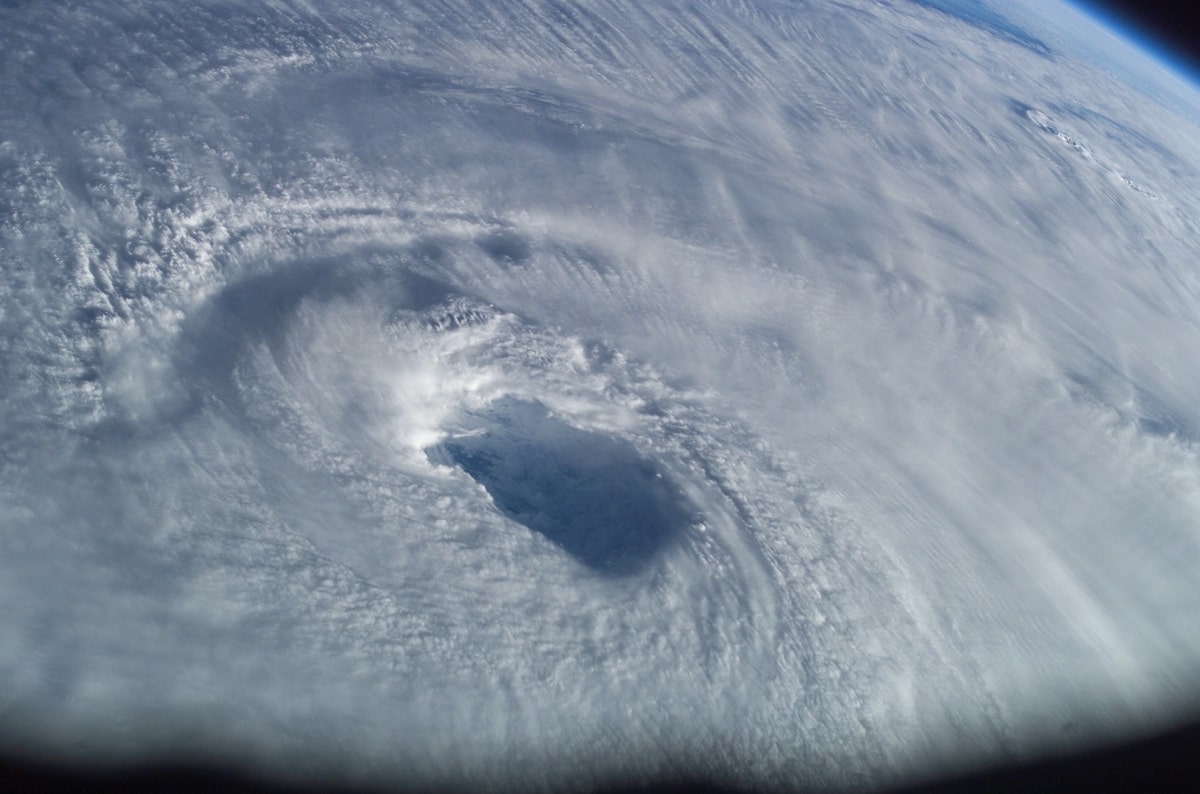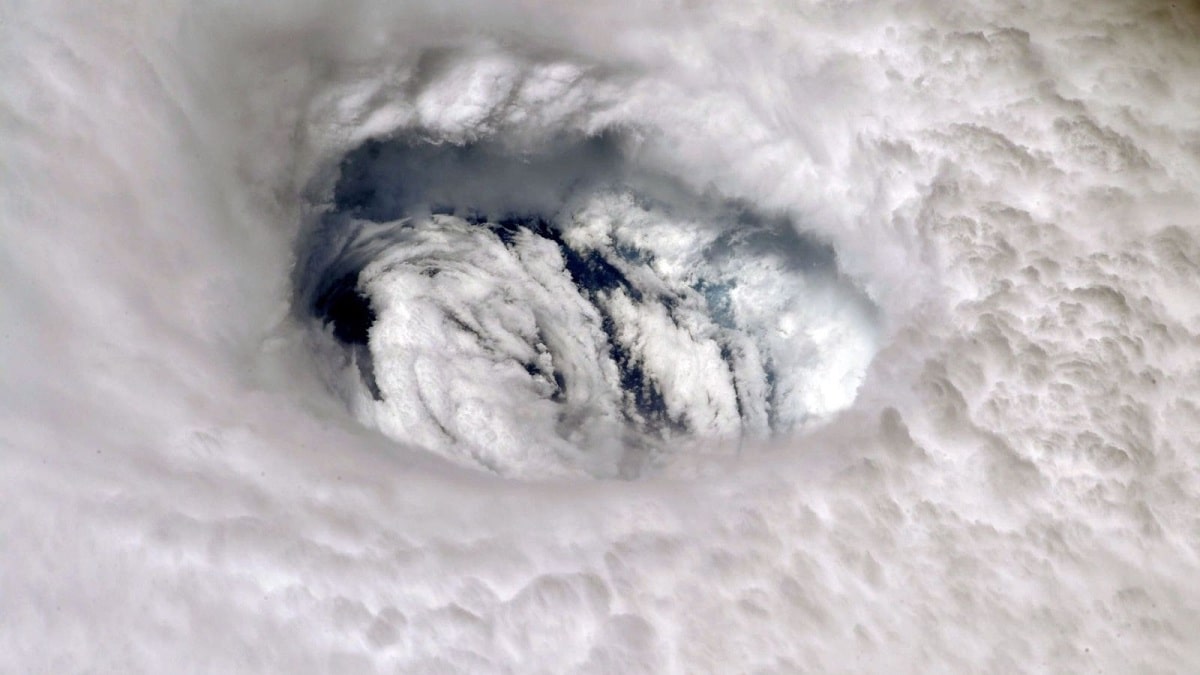
El eye of the storm it is like the “fingerprint” of the system, which tells us a lot about the processes that are happening in the cyclone at that moment. Forecasters use this information as a tropical cyclone analysis tool to predict how the storm will evolve in the coming hours. When we speak of the “eye of a cyclone system” we refer to that cloudless and apparently calm center, whether it is a hurricane or a tropical cyclone and a typhoon, because it is the same phenomenon, only it is developing in a different basin.
In this article we are going to tell you everything you need to know about the eye of the hurricane, how they are formed and what their characteristics are.
What is the eye of the hurricane

This is a nearly circular symmetrical area in the center of a severe tropical cyclone. In it a clear sky is glimpsed, and in the axis of symmetry, the wind is light. It can measure from 8 to 200 km in diameter, although most are usually between 30 and 60 km (Weatherford and Gray 1988).
The lowest pressure at surface level is recorded there, and the highest temperature is in the middle troposphere. NOAA explained that the intraocular temperature at an altitude of 12 km it could exceed the ambient temperature outside the storm by 10°C since the descending air was heated by compression.
formation of the eye of the hurricane

The exact mechanism that produces the eyes is still a matter of debate among scientists. One possible explanation is that the eye is the result of a vertical pressure gradient, related to shear and radial dispersion from high-altitude tangential winds. Another hypothesis is that the eye forms when latent heat is released from the wall to force the eye to flow downward.
The convection is organized in rain bands (narrow and elongated), parallel to the horizontal wind, spiraling towards the center of the cyclonic system (due to the Coriolis force due to the rotation of the Earth). Winds peaked in the lower levels, causing the storm's upper flow to diverge. The circulation is then caused by the convergence of warm, moist air at the surface (the rising belt), which then diverges and sinks higher in the sky (the flanking rain belts).
The sinking air is heated adiabatically and eventually flows into the center of the cyclone, where a rain band forms a wall around the eye. As a result, the eye does not appear cloudy, which may be the result of centrifugal effects that dynamically draw eye mass into wall and downdraft air to compensate for humid air convection on the same wall, explained the AOML.
The “eye wall” and its alternatives

The eye is bounded by an "eyewall" consisting of very high convective clouds. This ring has the strongest and most damaging winds at surface level. Air slowly descends through the eyes, but flows mainly upwards over the walls.
Severe hurricanes (Category 3 or higher) they often form so-called secondary eyewalls beyond the initial primary eyewall. They may even show two or more concentric eyewalls.
The diameter of the eye of a large hurricane can be reduced to 10-25 kilometers, at which point a few outer rainbands may organize an outer ring of thunderstorms, slowly moving in and out. Mainly humidity and speed. This weakens the inner wall and causes it to disappear, being replaced by the outer wall, this is called the "replacement cycle of the eye".
During this phase, the tropical cyclone begins to weaken for a short time, but then the storm may maintain its previous intensity, or (in some cases) gain more intensity, as happened before Hurricane Andrew made landfall in Miami (1992) . it was one of the most destructive tropical cyclones to hit the United States in the XNUMXth century.
why is it so quiet
The exact mechanism that produces the center is still debated and is influenced by various theories. To illustrate with an everyday example, it's like a clothes dryer: While spinning, a void is created in the center. Something similar happens in a hurricane, where multiple forces, including centrifugal ones, make the center a clean place.
There are also cases in which, in the eyes, due to the high temperature and the presence of hot air, the evaporated water is quickly drawn upwards, causing the air to dry out and not be able to condense, so they generally do not form. clouds. Currently, the presence of satellites and radars allows the Eye of the Hurricane to be tracked at any time. And reconnaissance planes often enter them to obtain data (their pressure is one of the main indicators of increased intensity). However, there are some signs that can help you detect that you are in the center of a hurricane (if you have the tools to measure it):
- Strong drop in atmospheric pressure in the area
- The temperature is usually 10 ºC above the ambient temperature
- Without instruments to measure these variables, it is enough to think that things do not improve quickly after a cyclone passes, and you could be right in front of you if there is a sudden calm.
However, the reason why the most intense part of a thunderstorm usually appears behind the eyes is to be found in physics. To give you an idea, take a look at where the water turns when it goes down the drain in your shower or sink. Under ideal physical conditions (not impeded by other leading forces or environmental conditions), it would always rotate counterclockwise if you lived in the northern hemisphere, and the opposite would happen if you lived in the southern hemisphere.
The reason behind this, discovered in the XNUMXth century, is known as the Coriolis effect and is the result of the Earth moving around its axis. This force spins hurricanes in the Northern Hemisphere counterclockwise.
I hope that with this information you can learn more about the eye of the hurricane and its characteristics.